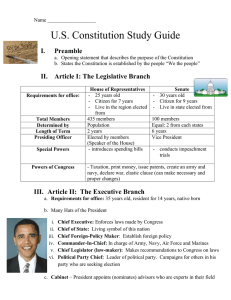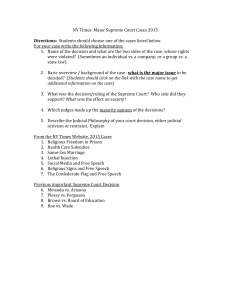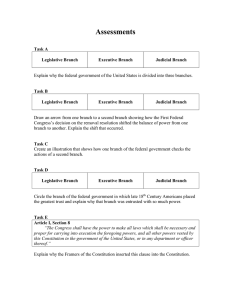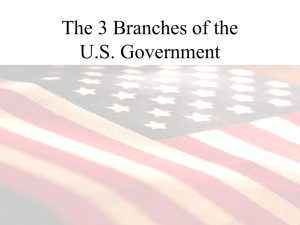Exam #2
advertisement
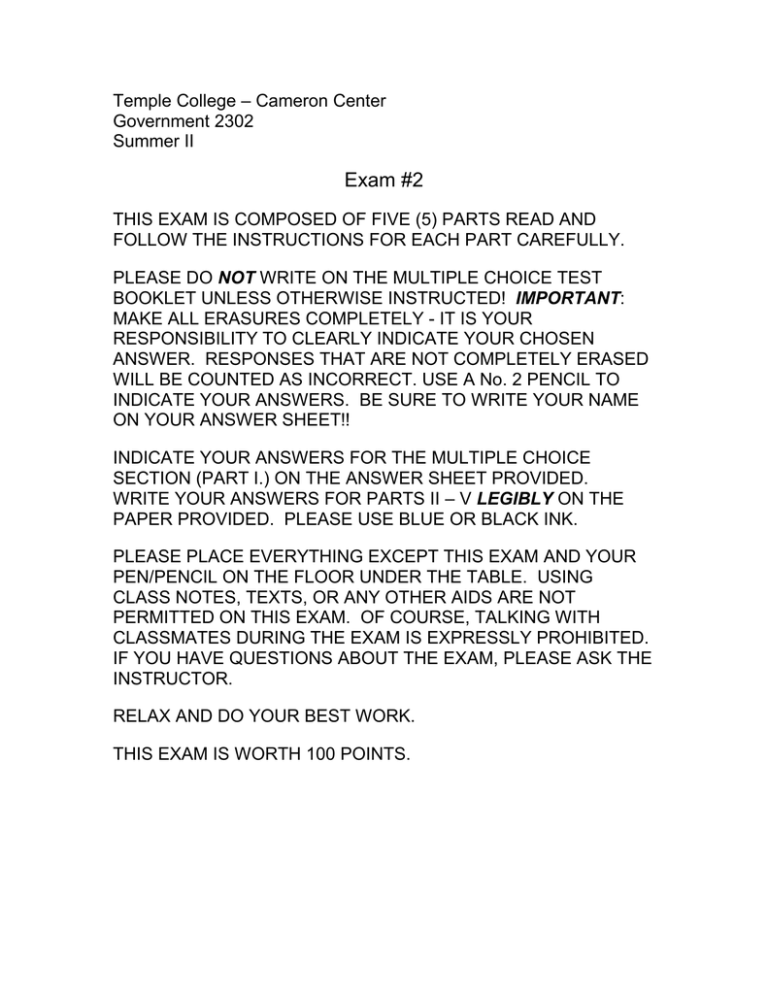
Temple College – Cameron Center Government 2302 Summer II Exam #2 THIS EXAM IS COMPOSED OF FIVE (5) PARTS READ AND FOLLOW THE INSTRUCTIONS FOR EACH PART CAREFULLY. PLEASE DO NOT WRITE ON THE MULTIPLE CHOICE TEST BOOKLET UNLESS OTHERWISE INSTRUCTED! IMPORTANT: MAKE ALL ERASURES COMPLETELY - IT IS YOUR RESPONSIBILITY TO CLEARLY INDICATE YOUR CHOSEN ANSWER. RESPONSES THAT ARE NOT COMPLETELY ERASED WILL BE COUNTED AS INCORRECT. USE A No. 2 PENCIL TO INDICATE YOUR ANSWERS. BE SURE TO WRITE YOUR NAME ON YOUR ANSWER SHEET!! INDICATE YOUR ANSWERS FOR THE MULTIPLE CHOICE SECTION (PART I.) ON THE ANSWER SHEET PROVIDED. WRITE YOUR ANSWERS FOR PARTS II – V LEGIBLY ON THE PAPER PROVIDED. PLEASE USE BLUE OR BLACK INK. PLEASE PLACE EVERYTHING EXCEPT THIS EXAM AND YOUR PEN/PENCIL ON THE FLOOR UNDER THE TABLE. USING CLASS NOTES, TEXTS, OR ANY OTHER AIDS ARE NOT PERMITTED ON THIS EXAM. OF COURSE, TALKING WITH CLASSMATES DURING THE EXAM IS EXPRESSLY PROHIBITED. IF YOU HAVE QUESTIONS ABOUT THE EXAM, PLEASE ASK THE INSTRUCTOR. RELAX AND DO YOUR BEST WORK. THIS EXAM IS WORTH 100 POINTS. PART I. MULTIPLE CHOICE. INSTRUCTIONS: Answer each of the following multiple choice questions by marking the letter on your scan-tron form that corresponds to the BEST response. 40 questions/60 points total. 1. Which two basic functions or responsibilities given Congress by the Constitution appear to be inherently at odds with one another? a. oversight and law-making b. law-making and representation c. representation and logrolling d. logrolling and redistricting 2. The concept of LOGROLLING refers to a. action taken by a senator that attempts to prevent a bill from passing in the Senate. b. a method that is used to keep one bill on the floor for an extended period of time, thus blocking all legislation. c. an arrangement by which two or more members of Congress agree in advance to support each other’s bills. d. a method that the president uses when he wants to prevent the passage of legislation. 3. Which of the following is most likely to use a filibuster? a. a House member who supports a bill that is likely to be passed by the majority. b. a Senator who supports a bill that is likely to be passed by the majority. c. a. a House member who opposes a bill that is likely to be passed by the majority. d. a Senator who opposes a bill that is likely to be passed by the majority. 4. A conference committee is a. a special committee convened to resolve the differences between the Congress and the president on legislative issues. b. called into session when the president has vetoed an appropriations bill with a pocket veto. c. a special committee convened to reconcile differences between House and Senate versions of a bill. d. a special committee in the House that assists the Speaker in enacting his party’s legislative agenda. 5. By far, the most important committees within Congress are the a. joint resolution committees. b. special investigative committees. c. standing committees. d. none of these. 6. According to the authors of the chapter on the Texas Legislature, all of the following are reasons for the high turnover rate among members of the state legislature except a. low legislative pay. b. Redistricting of legislative seats every ten years. c. Personal costs involved in running for public office. d. Major political scandals. 7. In Texas, the Speaker of the House and the lieutenant governor wield tremendous influence over the lawmaking process through their power to determine which a. member will serve in the pro tempore position. b. bills will be forwarded to the governor for signature. c. committee will have jurisdiction over a specific bill. d. members will serve on the governor’s advisory council. 8. The Texas state legislature meets in regular session a. annually for 140 days. b. Biennially for 140 days. c. Annually in open-ended sessions. d. Once every ten years for 140 days. 9. Which of the following statements would BEST characterize Americans' expectations regarding presidential leadership? a. Americans are generally undemanding of presidential leadership. b. Americans have unrealistically high expectations of their presidents. c. Americans are so thoroughly disgusted with presidential lying and corruption that they seem to have no expectations whatsoever of presidential leadership. d. The expectations of Americans are generally consistent with the reality of presidential power. 10. According to the Dye text, rather than commanding the executive branch of government, the president a. stands at its center trying to persuade. b. serves as its public relations person. c. more closely resembles a traffic cop. d. acts as the chief complaint-taker. 11. If you subscribed to the literalist theory of presidential power you would believe that the president has a. inherent powers. b. inherent and statutory powers. c. only express powers. d. no powers. 12. Which of the following powers are explicitly delegated to the president by the Constitution? 1. to be commander-in-chief 2. to act as manager of the economy 3. to be domestic crisis manager 4. to be chief foreign policy maker 5. to appoint the Speaker of the House of Representatives a. 1, 2, and 3 b. 1, 2, 3, and 4 c. all of these d. 1 only 13. The personal political skill of the president a. has little bearing on public perceptions of his leadership ability. b. is far less important than the constitutional powers of the president. c. is a primary source of presidential power. d. really does not vary much from one president to another. 14. Which of the following accurately describe the reality of presidential power? 1. unlimited 2. personal 3. negative 4. episodic 5. mythical a. 1 and 4 b. 1 and 5 c. 1, 2, and 3 d. 2, 3, and 4 15. Which term indicates that the president does NOT have the power to continuously control or manage the legislative process? a. limited b. episodic c. micromanage d. negative 16. According to the Dye text, the president’s authority over the executive branch is constitutionally very a. specific. b. vague. c. dynamic. d. static. 17. According to the Dye text, the early months of a president’s term in which his popularity with the public is generally high is known as the a. probationary period. b. learning curve. c. infancy period. d. honeymoon period. 18. According to the videotaped program “The Power Game,“ which of the following “games” is NOT one of the games a president must master to be a successful leader? a. the Agenda Game. b. the Coalition Game. c. the Persuasion Game. d. the Image Game. 19. According to the videotaped program “The Power Game, “ which of the following “games” requires a president to identify two or three major issues and convince Congress to devote its legislative energies to resolving dealing with these before taking on other problems? a. the Agenda Game b. the Coalition Game c. the Persuasion Game d. the Image Game 20. In which case did the Supreme Court first declare an act of Congress unconstitutional? a. MCCULLOCH V MARYLAND b. SHERBERT V VERNER c. PALKO V CONNECTICUT d. MARBURY V MADISON 21. Which of the following constitutes a "cue" (cue theory) that may indicate whether the Supreme Court will decide to hear a case on appeal? 1. The president or other high ranking federal officer publicly calls on the Supreme Court to review of the case. 2. The case involves a civil liberties or civil rights issue. 3. The judges on the lower appellate court have sharply divided opinions. 4. The subject matter of the case involves a social or political agenda that is consistent with the dominant ideology of the Supreme Court. 5. The case involves a question of federalism. a. 1, 2, & 5 b. 1, 2, & 3 c. 1, 2, 3, & 4 d. 1, 2, 3, & 5 22. Merits consciousness is the idea that a justice's 1. vote to grant certiorari reflects a predisposition by the justice to reverse a lower court's decision based on the merits of the case. 2. vote to deny certiorari reflects a predisposition by the justice to reverse a lower court's decision based on the merits of the case. 3. vote to grant or deny certiorari is highly associated with his or her political party ideology. 4. vote to grant or deny certiorari is highly associated with his or her political party affiliation. 5. vote to grant or deny certiorari is based strictly on the degree or extent of legal impact that he or she believes the decision will ultimately have. a. 1 only b. 1 & 2 c. 3 & 4 d. 5 only 23. The doctrine of stare decisis means a. to reverse a decision of a lower court. b. that the court does not have jurisdiction in a case. c. to refer a case to the next highest court. d. to stand on the decided cases - that is to decide a case based on the precedents set in other similar cases. 24. The power of the courts to decide whether an act of another branch of government is consistent with or contrary to the provisions of the Constitution is known as a. judicial review. b. writs of judicial appeal. c. the greater judicial need doctrine. d. the doctrine of common sense. 25. A writ of certiorari by the Supreme Court orders a. both parties in a case to reach a settlement without further litigation. b. a public official to discharge his or her duty. c. a lower court to send it the records of a case for review. d. the state legislature to rewrite legislation that was found to be unconstitutional. 26. According to the Dye text, rather than force, the courts derive their authority from the “rightness” of their decisions, referred to as the court’s a. prestige. b. legitimacy. c. political correctness. d. constitutional power. 27. Which of the following were established in class as criteria of judicial policymaking? a. legal impact and policy impact b. policy impact and compliance c. legal impact and compliance d. none of these 28. Which criterion of judicial policy-making refers to the "potential of a given court decision to substantially alter or change an existing policy or practice?" a. legal impact b. policy impact c. compliance d. none of these 29. The fact that public schools, particularly in the South, had not integrated two decades after the Supreme Court's decision in BROWN V BOARD OF EDUCATION illustrated the relevance of _______________ as a criterion of judicial policymaking. a. legal impact b. policy impact c. compliance d. none of these 30. The criterion of judicial policy-making that requires parties affected by a court’s decision to actually change or alter their behavior in accordance with the decision is a. legal impact b. policy impact c. compliance d. none of these 31. Which of the following cases meet both of the criteria of judicial policymaking? 1. GRISWOLD V CONNECTICUT 2. ENGEL V VITALE 3. MIRANDA V ARIZONA 4. PLESSY V FERGUSON 5. BAKER V CARR a. 1, 2, & 3 b. 1, 2, 3, & 4 c. 1, 2, 3, & 5 d. all of the above 32. In MARBURY V MADISON, the Supreme Court held that a. Madison had to deliver Marbury's judicial commission. b. Congress could not change the original jurisdiction of the Supreme Court. c. Congress could give the Supreme Court the power to issue writs of mandamus. d. all of these. 33. A writ of mandamus is a court order compelling a. both parties in a case to reach a settlement without further litigation. b. a public official to discharge his or her duty. c. a lower court to send it the records of a case for review. d. the state legislature to rewrite legislation that was found to be unconstitutional. 34. Judicial activism refers to a philosophy that a. implies a willingness on the part of judges to make liberal social policy. b. implies a reluctance on the part of judges to make liberal social policy. c. implies a willingness on the part of judges to use the power of judicial review to declare an act or action of another branch of government unconstitutional and, therefore, void. d. implies a reluctance on the part of judges to use the power of judicial review to declare an act or action of another branch of government unconstitutional and, therefore, void. For each of the following statements, mark “A” on your answer sheet to indicate the statement is true or “B” to indicate the statement is false. NOTE: These items are drawn from the assigned chapters on the “Texas Executive and Bureaucracy” and the “Texas Judiciary.” (items #35-40) 35. The governor of Texas is consistently ranked among the strongest in the country. 36. The Texas governor has line-item veto authority over the state budget. 37. Because of the Texas lieutenant governor’s key legislative role and statewide constituency, many experts consider this position to be one of the most powerful offices in the state. 38. Some 80% of state government employees work in three areas: higher education, public safety and corrections, and social services. 39. Most Texas judges are either women and (or) racial minorities. 40. Death penalty cases are appealed directly to the Texas Supreme Court. PART II. SHORT ANSWER 1. Answer one (1) of the following in a paragraph. Do NOT answer specific parts as separate items. Integrate your responses into a well-organized, well-constructed paragraph. Write complete sentences and pay attention to spelling, grammar, and word choice. Do NOT assume that “the instructor will know what you mean.” WRITE LEGIBLY IN INK! 10 points. 1. Discuss the legislative process. What is a “veto point”? Identify the primary veto points in the legislative process. How many veto points can (potentially) be associated with a typical bill in Congress? 2. List and explain at least three (3) factors that affect how representatives and senators in Congress decide how they will vote on legislation. PART III. SHORT ANSWER 2. Answer one (1) of the following in a paragraph. Do NOT answer specific parts as separate items. Integrate your responses into a well-organized, well-constructed paragraph. Write complete sentences and pay attention to spelling, grammar, and word choice. Do NOT assume that “the instructor will know what you mean.” WRITE LEGIBLY IN INK! 10 points. 1. What is meant by the “media presidency”? What is meant by the “textbook presidency”? How do these perpetuate a “mythological presidency”? Explain why the true nature of presidential power is negative, personal, and episodic. 2. Detail the constitutional basis of presidential power. Are the president’s powers broad and flexible or narrow and restricted? Explain your answer by contrasting the literalist and stewardship theories. PART IV. SHORT ANSWER 3. Answer one (1) of the following in a paragraph. Do NOT answer specific parts as separate items. Integrate your responses into a well-organized, well-constructed paragraph. Write complete sentences and pay attention to spelling, grammar, and word choice. Do NOT assume that “the instructor will know what you mean.” WRITE LEGIBLY IN INK! 10 points. 1. What do we mean when we say that a court decision has policy impact? How does this differ from legal impact? Give (at least three) examples of U.S. Supreme Court decisions that have policy impact. Explain each example. 2. What is judicial review? Discuss the “historical birth” of judicial review in MARBURY V MADISON [1803]. What were the facts of the case? What was the constitutional issue? What did the USSC decide? What was the long-term significance of the case? PART V. IDENTIFICATION. Define and identify the importance of five (5) of the following items in two or three sentences for each item. 10 points/2 pts. each. filibuster cloture safe seat open seat trustee 25th Amendment judicial review stare decisis writ of certiorari writ of mandamus


